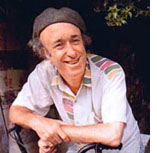By Danny Bloom

CHIAYI CITY, TAIWAN — There aren’t many bubbies or zadies in Taiwan, although there are, of course, lots of elderly grandmas and grandpas among the island nation’s 23 million people. Grandmothers are lovingly called “Amah” and grandfathers “Akong.” And like grandmas and grandpas everywhere, they get sick and die, and children wonder what it’s all about, as all children do the world over. So when I heard about a new children’s book covering this subject that is being published in the United States by a Jewish writer, I leapt at the chance to interview her.
Sheri Sinykin is a prolific children’s book author, and this fall she has a big (and powerful) book coming out about death and dying, titled Zayde Comes to Live. The message inside the 32-page picture book isemotive, heartfelt. and not only for children. of course. And not once, in the entire book, I learned during the course of our interview, is the word “God” mentioned. Let me explain.
While this is Sinykin’s 19th children’s book, and her first in a ”picture book” format, for this book she’s “presenting it to adults who love children, rather than to children themselves,” she told me in a recent email. Why? “Because I have no way of knowing where individual children are in their lives — they have a dying relative, if they have no awareness of death (and no reason to think about it yet), if they are highly emotional or fearful, if they themselves might be sick. I am sensitive to the fact that children ages five to ten age developmentally, and I want a reading of this book to be with someone who knows and loves that child rather than with a stranger who is ‘thrusting’ it upon them.
To do this, Sinykin has created a Power Point presentation for the book, explaining: “People, in general, are more engaged when they see as well as hear information — hence the Power Point — and it alsoserves as an outline to keep me on track when I am speaking. With a picture book, Power Point enables the whole audience to see the illustrations during a reading.”
When I asked Sheri how the theme of the book come to her and if there was a special event or incident in her own life that brought this theme to the fore, she replied by email: “I explored the theme of death and home hospices in two earlier middle school novels. Both books were inspired by my mother’s 1997 diagnosis of Stage 4B endometrial cancer — shocking news after a surgery that was prompted by an abnormal PAP smear test on a routine physical.”
“She and I were very close, and I was plunged into despair and a long period of writer’s block,” Sinykin added. “I realized how terrified I was of death, in general, and her death, in particular. Amazingly, she parlayed a ‘less than five percent chance of living two years’ into more than eight years of sharing life cycle events with me and my sons. But my response was to become a hospice volunteer and to
learn how to be with the dying, so that I would be able to be there for my mom, when her time came. During my years as a volunteer, I met a hospice rabbi. He shared the opinion that Jewish patients in hospice tend to have much more trouble accepting death than other patients because they lacked a clear religious vision around death and the afterlife. We Jews tend to focus on the here-and-now, on doing mitzvah for its own sake rather than for the promise of getting into a specific hereafter.”
These issues put Sinykin on the path to writing this new book, step by step. “Because I wondered what we Jews actually believe, I interviewed a couple rabbis and did some research about that,” she told me.”Another element was my awareness that Jewish children don’t know how to reply when friends assure them their loved one ‘will go’ to Heaven if he or she believes in Jesus, or to Paradise if he or she believes in Allah.”
In another response to her mother’s illness, Sheri decided to go back to graduate school at Vermont College, earning in 2003 an MFA in Writing for Children.
In the new picture book, to be published in October by Peachtree Books, ‘Zayde’ comes to live in Rachel’s house because he is dying.
When I asked Sinykin what the character of Zayde was dying from she replied; “I modeled Zayde’s illness after that of a hospice patient I followed for the better part of a year. He had congestive heart failure and was in his mid-80s.”
Finally, I asked Sheri if she thinks or hopes her book will help open up discussions nationwide about terminal illness and how young children should be told about it. Her answer is instructive.
“I’m not a great believer in ‘shoulds,’ she said. “But I hope the book will provide a framework for talking about death in a comforting, understandable way with young children — especially Jewish children — at a time when such a discussion feels appropriate or necessary.”
*
Bloom is Taiwan bureau chief and an inveterate web surfer for San Diego Jewish World. He may be contacted at dan.bloom@sdjewishworld.com